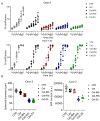EGFR-Targeted Antibody-Drug Conjugate to Different Aminobisphosphonates: Direct and Indirect Antitumor Effects on Colorectal Carcinoma Cells
- PMID: 38610932
- PMCID: PMC11011001
- DOI: 10.3390/cancers16071256
EGFR-Targeted Antibody-Drug Conjugate to Different Aminobisphosphonates: Direct and Indirect Antitumor Effects on Colorectal Carcinoma Cells
Abstract
Antibody--drug conjugates (ADCs) are a promising delivery system that involves linking a monoclonal antibody (mAb) to a specific drug, such as a cytotoxic agent, to target tumor cells. This new class of antitumor therapy acts as a "biological missile" that can destroy tumor cells while increasing the therapeutic index and decreasing toxicity. One of the most critical factors in ADC design is selecting a target antigen that is highly expressed on the surface of cancer cells. In this study, we conjugated Cetuximab (Cet), a monoclonal antibody that targets the epidermal growth factor receptor (EGFR), to aminobisphosphonates (N-BPs) such as ibandronate (IBA) or risedronate (RIS) or zoledronate (ZA). Cetuximab is administered to patients with metastatic colorectal carcinoma (mCRC) with a wild-type (WT) EGFR transduction pathway. Also, it is well established that N-BPs can trigger the antitumor activity of Vδ2 T cells in both in vitro and in vivo experimental models. The resulting ADCs were added in co-culture to assess the effect on CRC cell line proliferation and sensitivity to Vδ2 T antitumor lymphocytes in comparison with the native antibody. These assays have been performed both in conventional and 3D spheroid cultures. We found that all three ADCs can increase the inhibitory effect on cell proliferation of the WT-EGFR cell line Caco-2 while only Cet-RIS and Cet-ZA can increase the cytotoxicity mediated by Vδ2 T cells against both WT and EGFR-mutated CRC cell lines (Caco-2, DLD-1, and HCT-116). Also, the ADCs can trigger the cell proliferation of Vδ2 T cells present in peripheral blood and tumor specimens. Our findings indicate that anti-EGFR antibodies bound to N-BPs can improve the antitumor effects of the native antibody possibly increasing the therapeutic effect.
Keywords: aminobisphosphonate; antibody–drug conjugate; colorectal cancer; epidermal growth factor receptor; gamma delta T lymphocyte.
Conflict of interest statement
The authors declare no conflicts of interest. The funders had no role in the design of the study; in the collection, analyses, or interpretation of data; in the writing of the manuscript; or in the decision to publish the results.
Figures







References
-
- Glatt D.M., Beckford Vera D.R., Prabhu S.S., Mumper R.J., Luft J.C., Benhabbour S.R., Parrott M.C. Synthesis and Characterization of Cetuximab-Docetaxel and Panitumumab-Docetaxel Antibody-Drug Conjugates for EGFR-Overexpressing Cancer Therapy. Mol. Pharm. 2018;15:5089–5102. doi: 10.1021/acs.molpharmaceut.8b00672. - DOI - PubMed
-
- Zhang K., Ma Y., Guo Y., Sun T., Wu J., Pangeni R.P., Lin M., Li W., Horne D., Raz D.J. Cetuximab-Triptolide Conjugate Suppresses the Growth of EGFR-Overexpressing Lung Cancers through Targeting RNA Polymerase II. Mol. Ther. Oncolytics. 2020;18:304–316. doi: 10.1016/j.omto.2020.07.001. - DOI - PMC - PubMed
Grants and funding
LinkOut - more resources
Full Text Sources
Research Materials
Miscellaneous

